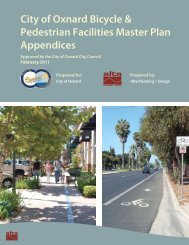View File - Development Services - City of Oxnard
View File - Development Services - City of Oxnard
View File - Development Services - City of Oxnard
Create successful ePaper yourself
Turn your PDF publications into a flip-book with our unique Google optimized e-Paper software.
WATER RESOURCES TECHNICAL REPORTmulti-year wet periods are indicated by rising values. Figure 2-5 indicates four longer-termdry/wet cycles through 1998:Historical Dry and Wet PeriodsDry PeriodWet PeriodCycle Period Years Period Years1 1890 - 1904 15 1904 - 1918 152 1918 - 1934 17 1934 - 1944 113 1944 - 1977 34 1977 - 1983 74 1983 - 1991 9 1991 - 1998 8ENSO refers to a seesaw shift in surface air pressure at Darwin, Australia, and theSouth Pacific Island <strong>of</strong> Tahiti. When the pressure is high at Darwin, it is low at Tahiti andvice versa. El Niño, and its sister event-La Niña-are the extreme phases <strong>of</strong> the southernoscillation, with El Niño referring to a warming <strong>of</strong> the eastern tropical Pacific, and La Niñaas cooling. El Niño brings heavy rains and blustery storms to Southern California, whileLa Niña brings dry conditions. El Niño recurs irregularly, from 2 years to a decade; and notwo events are exactly alike. During the past 40 years, nine El Niño events have affected thewestern coasts <strong>of</strong> North and South America. Most <strong>of</strong> them have raised water temperaturesalong 5,000 miles <strong>of</strong> coast. The weaker events raised sea temperatures only a few degreesFahrenheit and caused mild changes in weather. But the strong ones, like the El Niño <strong>of</strong>1982-83, left a climatic imprint that was global in extent.The PDO is a long-lived El Niño-like pattern <strong>of</strong> Pacific climate variability. While the twoclimate oscillations have similar spatial climate fingerprints, they have very differentbehavior in time. Two main characteristics distinguish PDO from ENSO. First, 20th centuryPDO "events" persisted for 20 to-30 years, while typical ENSO events persisted for 6 to18 months. Second, the climatic fingerprints <strong>of</strong> the PDO are most visible in the NorthPacific/North American sector; while secondary signatures exist in the tropics , the oppositeis true for ENSO. Several studies find evidence for just two full PDO cycles in the pastcentury:PDO Regime Duration Period“Cool” or 35 years 1890-1924"Warm” 22 years 1925-1946“Cool” 30 years 1947-1976"Warm" -- 1977 through (at least) the mid-1990'sCauses <strong>of</strong> the PDO are currently not well understood. As described below, groundwaterlevels are correlated to these longer-term climatic patterns. In general, groundwater levelsincrease with wetter climatic periods representing increased recharge and reducedpumping, while they decrease with drier climatic periods representing decreased rechargeW112003002SCO LW1458.DOC/ 033390002 9
















